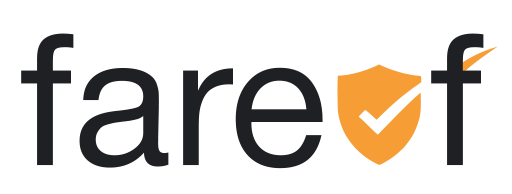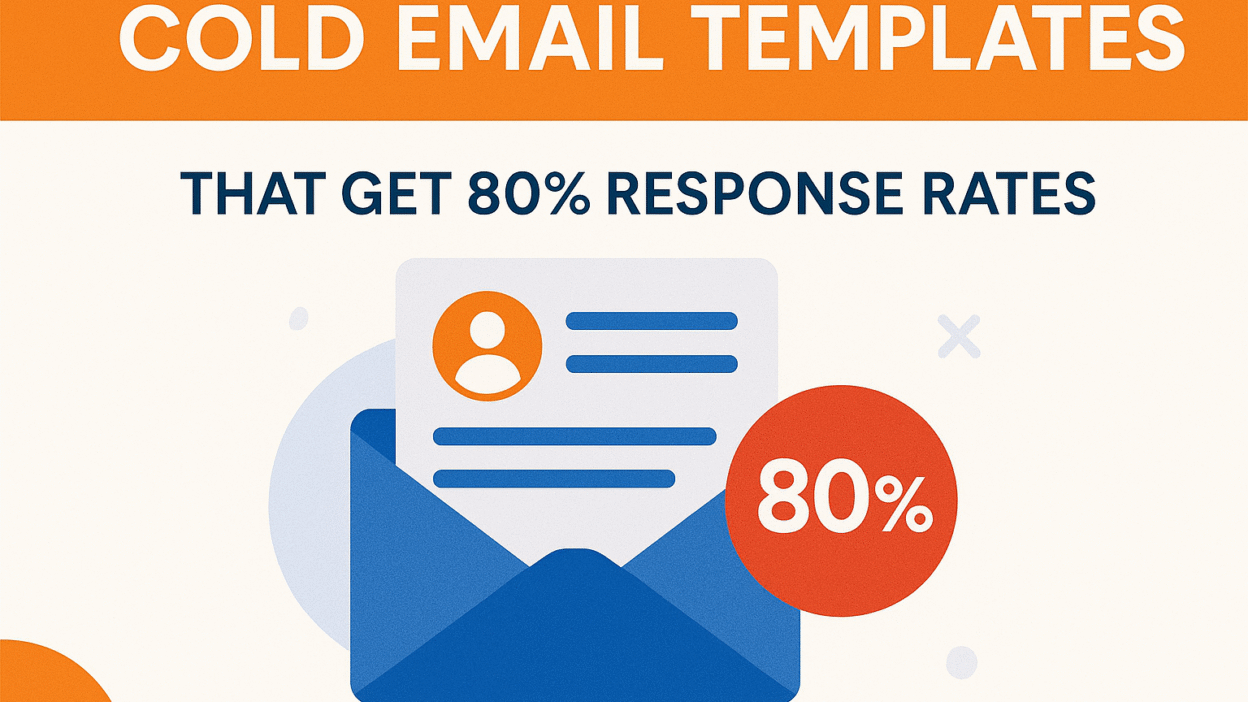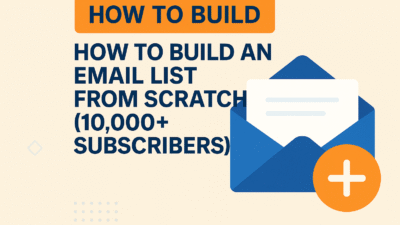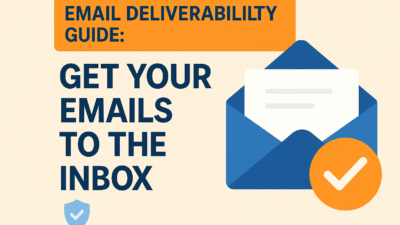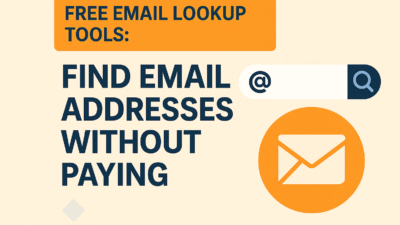TL;DR
Cold email templates with exceptional response rates combine personalization, value delivery, and strategic psychology to engage prospects effectively. Most cold emails fail because they focus on sender needs rather than recipient value, leading to low response rates and missed business opportunities through generic messaging and poor targeting.
The reality is that achieving high response rates requires systematic approaches that combine research, personalization, and value creation rather than template copying. Without understanding why templates work and how to adapt them for specific audiences, businesses often see minimal results despite using “proven” examples.
Effective cold email templates follow psychological principles that build trust, demonstrate value, and create compelling reasons for response while respecting recipient time and preferences. The most successful sales professionals use template frameworks rather than exact copies, adapting messaging for specific prospects and situations.
This comprehensive guide provides high-converting cold email templates with analysis of why they work, customization strategies, and implementation guidance for different industries and use cases. We’ll explore subject lines, body copy, call-to-action optimization, and follow-up sequences that drive consistent response rates.
Whether you’re starting cold outreach, optimizing existing campaigns, or scaling successful approaches, these templates and strategies will help you achieve exceptional response rates while building genuine professional relationships and business opportunities.
Psychology Behind High-Response Cold Emails
Understanding psychological principles that drive email responses enables strategic template development while creating compelling communication that resonates with recipient motivations and decision-making processes.
Cognitive Biases That Influence Responses
Human psychology includes predictable patterns that affect email response behavior, enabling strategic messaging that aligns with natural decision-making processes and motivational triggers.
Social proof leveraging demonstrates credibility through client mentions, case studies, and industry recognition that builds trust and encourages recipient engagement through established authority.
Scarcity and urgency psychology creates motivation through limited availability and time sensitivity while encouraging prompt response and decision-making through psychological pressure.
Reciprocity principle application provides value upfront through insights, resources, or assistance while creating psychological obligation and encouraging positive response through mutual benefit.
Authority positioning establishes expertise through credentials, achievements, and industry recognition while building trust and encouraging engagement through professional credibility.
Curiosity gap creation generates interest through incomplete information and compelling questions while motivating recipients to respond for additional details and resolution.
Trust Building Through Email Communication
Trust development enables response generation while overcoming natural skepticism and resistance that prospects have toward unsolicited communication from unknown senders.
Transparent sender identification clearly states name, company, and purpose while building credibility and reducing suspicion through honest communication and professional presentation.
Mutual connection references leverage shared relationships and professional networks while building trust through familiar associations and social validation.
Industry expertise demonstration showcases relevant knowledge and experience while building confidence in sender capability and value proposition through professional competence.
Professional communication standards maintain formal yet approachable tone while respecting recipient status and building trust through appropriate business communication.
Authenticity and genuineness avoid sales-heavy language while focusing on relationship building and mutual benefit through sincere communication approaches.
Value Proposition Development
Compelling value propositions drive response rates while clearly communicating benefits and outcomes that matter to specific recipients and their business objectives.
Problem identification and solution addresses specific pain points while demonstrating understanding of recipient challenges and presenting relevant solutions that provide clear value.
Quantifiable benefit presentation includes specific metrics and outcomes while making value concrete and measurable for recipient evaluation and decision-making.
Risk reduction emphasis addresses concerns and uncertainties while building confidence in proposed solutions and reducing barriers to engagement and response.
Competitive advantage highlighting differentiates offerings while positioning unique value and superior outcomes that justify recipient time investment and consideration.
ROI demonstration connects solutions with financial outcomes while making business case for engagement and creating compelling reasons for response and further discussion.
Emotional Engagement Strategies
Emotional connection drives response rates while creating personal investment and engagement that transcends purely logical evaluation and decision-making processes.
Empathy and understanding acknowledges recipient challenges while demonstrating genuine concern and creating emotional connection through shared professional experiences.
Success story sharing inspires confidence through client achievements while creating emotional connection to positive outcomes and success possibilities.
Professional aspiration alignment connects with career goals while demonstrating understanding of recipient motivations and professional development objectives.
Challenge acknowledgment recognizes industry difficulties while building credibility and creating shared understanding of professional challenges and market conditions.
Future vision painting describes positive outcomes while creating emotional investment in potential success and professional advancement opportunities.
Template Framework Analysis
Effective cold email templates follow structured frameworks that maximize response probability while maintaining professional standards and creating compelling value propositions.
Subject Line Optimization
Subject lines determine open rates while creating first impressions that influence recipient willingness to engage with email content and sender messages.
Personalization elements include recipient names, companies, or specific references while increasing relevance and attention through individual targeting and customization.
Curiosity generation creates interest through incomplete information while motivating opens through psychological gaps that require resolution and additional information.
Value proposition preview hints at benefits while encouraging opens through clear indication of potential value and relevant content for recipient interests.
Question-based engagement encourages interaction through thought-provoking questions while creating dialogue opportunities and recipient investment in communication.
Professional yet conversational tone balances formality with approachability while maintaining business standards and encouraging engagement through accessible communication.
Opening Line Strategies
Email openings establish tone while capturing attention and creating foundation for continued reading and engagement throughout the entire message.
Relevant compliment delivery acknowledges recipient achievements while building positive tone and demonstrating research investment in understanding their professional success.
Industry insight sharing provides valuable information while establishing expertise and creating immediate value for recipients through relevant knowledge and perspective.
Mutual connection mentions leverage shared relationships while building trust and credibility through familiar professional associations and social validation.
Recent company news references demonstrate research while showing genuine interest in recipient organization and creating relevant conversation starters.
Problem statement presentation identifies challenges while demonstrating understanding of recipient situation and creating foundation for solution presentation and value delivery.
Value Delivery Mechanisms
Value creation drives response rates while demonstrating sender capability and creating compelling reasons for continued engagement and relationship development.
Free resource offering provides immediate value while demonstrating expertise and creating reciprocity obligation that encourages response and further engagement.
Industry insight sharing delivers valuable information while positioning sender as knowledgeable resource and building credibility through professional expertise.
Specific solution presentation addresses identified problems while demonstrating capability and creating clear connection between needs and available solutions.
Success metric sharing quantifies potential outcomes while making value concrete and compelling for recipient evaluation and decision-making processes.
Risk-free proposition reduces engagement barriers while encouraging response through low-commitment opportunities and minimal recipient investment requirements.
Call-to-Action Optimization
Strategic calls-to-action drive specific responses while making engagement easy and compelling for recipients to take desired actions and continue conversations.
Single, clear request focuses attention while avoiding confusion and making response decision simple and straightforward for busy professionals.
Low-commitment asks reduce barriers while encouraging initial engagement through minimal time investment and low-risk interaction opportunities.
Specific timing suggestions facilitate scheduling while making response easier through concrete options and removing decision-making friction for recipients.
Multiple response options accommodate preferences while providing flexibility and increasing likelihood of engagement through varied interaction possibilities.
Urgency without pressure encourages prompt response while maintaining professional respect and avoiding aggressive tactics that could damage relationships.
High-Converting Template Categories
Different template types serve specific purposes while addressing various outreach scenarios and business objectives through specialized messaging approaches and strategic frameworks.
The Value-First Template
Value-first approaches build trust while demonstrating expertise and creating compelling reasons for engagement through upfront benefit delivery and professional service.
Template Structure:
Subject: Quick insight about [Company]'s [specific challenge/opportunity]
Hi [Name],
I noticed [specific observation about their company/recent news/achievement] and thought you might find this interesting.
[Industry/specific companies] typically see [specific benefit/outcome] when they [relevant action/strategy]. For example, [brief case study or metric].
I put together a brief analysis of how this might apply to [Company]. Would you be interested in a 5-minute conversation to share what I found?
Best regards,
[Your name]
Why This Works: The value-first approach demonstrates expertise while providing immediate benefit that creates reciprocity and encourages response through upfront value delivery.
Customization Strategy: Research specific company challenges while tailoring insights and case studies to recipient industry and organizational characteristics for maximum relevance and impact.
Response Rate Factors: Industry-specific insights and relevant case studies create compelling value while demonstrating sender expertise and building trust through professional knowledge.
The Mutual Connection Template
Referral-based outreach leverages social proof while building immediate trust through shared professional relationships and familiar associations.
Template Structure:
Subject: [Mutual connection] suggested I reach out
Hi [Name],
[Mutual connection] mentioned you're working on [specific project/challenge] and suggested I reach out.
I recently helped [similar company] with [similar challenge], and they saw [specific result]. [Mutual connection] thought our approach might be relevant for [Company].
Would you be open to a brief conversation to explore whether our experience might be helpful for your situation?
Best,
[Your name]
Why This Works: Social proof through mutual connections builds immediate trust while creating warm introduction atmosphere that overcomes cold outreach resistance.
Customization Strategy: Verify mutual connection approval while researching their relationship depth and ensuring appropriate introduction context for professional credibility.
Response Rate Factors: Trusted third-party validation creates credibility while reducing recipient skepticism and building foundation for positive engagement and relationship development.
The Problem-Solution Template
Problem-focused approaches demonstrate understanding while presenting relevant solutions that address specific pain points and business challenges.
Template Structure:
Subject: Solving [specific problem] at [Company]
Hi [Name],
I noticed [Company] is [specific situation/challenge based on research]. Many [industry] companies face similar challenges with [specific pain point].
We recently helped [similar company] overcome this by [specific solution], resulting in [specific outcome/metric].
I'd love to share how we approached this challenge. Are you available for a brief call this week?
Best regards,
[Your name]
Why This Works: Problem identification demonstrates understanding while solution presentation creates clear value proposition and compelling reason for engagement.
Customization Strategy: Research specific company challenges while identifying relevant pain points and positioning solutions that address actual business needs and objectives.
Response Rate Factors: Relevant problem identification creates engagement while specific solutions demonstrate capability and provide clear pathway to value realization.
The Compliment-Based Template
Recognition-focused outreach builds positive relationships while creating goodwill and encouraging response through genuine appreciation and professional acknowledgment.
Template Structure:
Subject: Impressed by [specific achievement/initiative]
Hi [Name],
I came across [specific achievement/article/initiative] and was really impressed by [specific detail]. [Specific compliment about their work/company direction].
Your approach to [specific aspect] reminded me of work we've done with [similar company], where we achieved [specific result].
I'd love to learn more about your experience with [relevant topic]. Would you be open to a brief conversation?
Best,
[Your name]
Why This Works: Genuine compliments create positive tone while demonstrating research investment and building foundation for professional relationship development.
Customization Strategy: Research recent achievements while identifying specific accomplishments that warrant genuine recognition and create natural conversation opportunities.
Response Rate Factors: Authentic recognition builds goodwill while creating positive association and encouraging engagement through appreciated professional acknowledgment.
Industry-Specific Template Variations
Different industries require tailored approaches while addressing unique characteristics, communication preferences, and business priorities that affect response rates and engagement patterns.
Technology and Software Industry
Technology professionals respond to data-driven approaches while appreciating technical competence and specific solution focus that demonstrates industry understanding.
SaaS Cold Email Template:
Subject: Reducing churn by 23% for SaaS companies like [Company]
Hi [Name],
I saw [Company] recently raised [amount] for [specific purpose] and thought you might be interested in how other SaaS companies are improving retention.
We helped [similar SaaS company] reduce churn from [%] to [%] in [timeframe] by implementing [specific technical solution]. The key was [specific insight about SaaS retention].
I put together a brief analysis of retention optimization for companies in your growth stage. Would you be interested in a 10-minute call to discuss what we found?
Best,
[Your name]
Industry Customization Elements:
- Specific SaaS metrics and KPIs
- Technical solution details
- Growth stage considerations
- Platform-specific challenges
Healthcare and Medical Services
Healthcare outreach requires compliance awareness while addressing regulatory considerations and professional standards that affect communication and solution implementation.
Healthcare Cold Email Template:
Subject: HIPAA-compliant solution that saved [Similar Organization] $[amount]
Hi Dr. [Name],
I noticed [Healthcare Organization] is expanding [specific service] and thought you might be interested in how other [similar healthcare organizations] are addressing [specific healthcare challenge].
We recently helped [similar healthcare org] achieve [specific healthcare outcome] while maintaining full HIPAA compliance. They saw [specific metric improvement] in [timeframe].
Would you be open to a brief call to discuss how this approach might benefit [Organization]?
Respectfully,
[Your name]
Healthcare Customization Elements:
- Compliance and regulatory focus
- Patient outcome emphasis
- Professional hierarchy respect
- Evidence-based approach
Financial Services Industry
Financial professionals value risk management while requiring compliance awareness and conservative approaches that acknowledge regulatory requirements and fiduciary responsibilities.
Financial Services Cold Email Template:
Subject: Risk management insights for [Company]
Hi [Name],
I noticed [Company] recently [specific business development] and thought you might be interested in how other [financial service type] firms are addressing [specific regulatory/market challenge].
We helped [similar financial firm] navigate [specific challenge] while maintaining compliance with [relevant regulation]. They achieved [specific business outcome] without increasing risk exposure.
Would you be available for a brief conversation about risk management strategies in the current regulatory environment?
Best regards,
[Your name]
Financial Services Customization Elements:
- Regulatory compliance focus
- Risk management emphasis
- Conservative language tone
- Fiduciary responsibility awareness
Manufacturing and Industrial
Manufacturing professionals appreciate efficiency focus while valuing practical solutions and ROI demonstration that address operational challenges and cost optimization.
Manufacturing Cold Email Template:
Subject: Reducing production costs by 15% at [Company]
Hi [Name],
I saw [Company] is expanding operations in [location] and thought you might be interested in how other manufacturers are optimizing efficiency during growth phases.
We recently helped [similar manufacturer] reduce production costs by [%] while increasing output by [%] through [specific operational improvement]. The ROI was [specific timeframe].
Would you be open to a brief call to discuss operational optimization strategies for growing manufacturers?
Best,
[Your name]
Manufacturing Customization Elements:
- Operational efficiency focus
- Cost reduction emphasis
- Production metrics inclusion
- Practical solution orientation
Personalization Strategies That Work
Effective personalization goes beyond name insertion while creating genuine relevance and connection that demonstrates research investment and builds recipient engagement.
Research-Based Personalization
Comprehensive research enables authentic personalization while creating relevant messaging that resonates with specific recipient circumstances and professional interests.
Company-specific insights include recent news, funding announcements, expansion plans, and strategic initiatives that create relevant conversation starters and demonstrate research investment.
Individual achievement recognition acknowledges personal accomplishments, professional milestones, and career developments that create positive tone and show genuine interest in recipient success.
Industry trend awareness demonstrates market knowledge while positioning relevant insights and solutions that address current challenges and opportunities within specific sectors.
Competitive landscape understanding shows market awareness while identifying differentiation opportunities and positioning relevant solutions for competitive advantage.
Technology stack identification reveals tools and platforms used while enabling relevant solution positioning and demonstrating technical understanding of recipient environment.
Social Media Intelligence
Social platform research provides personalization opportunities while revealing professional interests and recent activities that create natural conversation opportunities.
LinkedIn activity monitoring identifies recent posts, job changes, and professional updates that create timely outreach opportunities and relevant conversation starters.
Twitter engagement analysis reveals professional interests and industry opinions while providing insight into thought leadership and professional focus areas.
Company social media presence shows brand personality and marketing focus while enabling relevant positioning and appropriate communication tone adaptation.
Professional content sharing identifies expertise areas while creating opportunities for relevant value delivery and professional discussion topics.
Industry conference participation reveals professional interests while creating networking opportunities and shared experience conversation starters.
Trigger Event Identification
Timing-based personalization leverages business events while creating relevant outreach opportunities that align with recipient priorities and organizational changes.
Funding announcements create expansion-focused messaging opportunities while positioning growth-enabling solutions and addressing scaling challenges.
Leadership changes provide introduction opportunities while addressing new priorities and strategic direction changes that create solution needs.
Product launches enable congratulatory outreach while identifying partnership opportunities and relevant service positioning for market expansion.
Company expansions create relevant solution positioning while addressing operational challenges and growth-related needs that require external support.
Industry award recognition provides compliment opportunities while building positive relationships and creating foundation for professional discussion and engagement.
Geographic and Cultural Adaptation
Location-based customization ensures cultural sensitivity while adapting communication styles for regional preferences and business practices.
Regional business customs influence communication tone while requiring adaptation for different cultural expectations and professional interaction norms.
Local market conditions affect solution positioning while enabling relevant messaging that addresses specific regional challenges and opportunities.
Time zone consideration shows respect while optimizing outreach timing for recipient availability and professional schedule patterns.
Language preferences accommodate international recipients while ensuring clear communication and appropriate professional tone for different cultural contexts.
Regulatory environment awareness demonstrates market knowledge while positioning compliant solutions that address local requirements and business practices.
Follow-Up Sequence Templates
Systematic follow-up creates multiple engagement opportunities while maintaining professional persistence that increases response probability without becoming invasive or annoying.
Initial Follow-Up (3-5 Days)
First follow-up maintains momentum while providing additional value and creating second opportunity for engagement without repetitive messaging.
Follow-Up Template 1:
Subject: Re: [Original subject] + additional insight
Hi [Name],
I wanted to follow up on my previous email about [topic] and share an additional insight that might be relevant.
[New piece of value/insight/case study that wasn't in original email]
This approach has helped [number] companies in [industry] achieve [specific outcome].
Still interested in a brief conversation about how this might apply to [Company]?
Best,
[Your name]
Value Addition Strategy: Each follow-up should provide new value while building on previous communication and creating cumulative case for engagement.
Second Follow-Up (1 Week)
Second follow-up acknowledges busy schedules while providing different value angle and maintaining professional persistence without pressure.
Follow-Up Template 2:
Subject: Quick question about [Company]'s [relevant priority]
Hi [Name],
I know you're busy, so I'll keep this brief.
Quick question: Is [specific challenge/priority] still a focus for [Company] this quarter?
If so, I have a case study from [similar company] that might interest you - they solved this exact challenge and saw [specific result] in [timeframe].
Worth a 5-minute conversation?
Best,
[Your name]
Engagement Strategy: Questions create interaction opportunities while demonstrating continued interest and providing easy response mechanisms.
Third Follow-Up (2 Weeks)
Third follow-up changes approach while acknowledging communication attempts and providing final value opportunity before stepping back.
Follow-Up Template 3:
Subject: Last note about [specific value proposition]
Hi [Name],
I don't want to be a pest, so this will be my last email about [topic].
I put together a brief resource about [relevant topic] that might be valuable even if we don't connect. No strings attached - just thought it might be helpful for [Company]'s work in [relevant area].
[Link to valuable resource/study/report]
If you ever want to discuss [topic] in the future, feel free to reach out.
Best regards,
[Your name]
Graceful Exit Strategy: Final follow-up maintains professionalism while providing lasting value and keeping door open for future engagement.
Re-engagement After Time Gap
Long-term follow-up leverages new developments while creating fresh engagement opportunities that acknowledge time passage and changed circumstances.
Re-engagement Template:
Subject: New development that changes [relevant industry/challenge]
Hi [Name],
It's been a few months since I reached out about [original topic]. I wanted to circle back because something significant has changed in [industry/area].
[New development/trend/regulation] is creating [new opportunity/challenge] for companies like [Company]. We've been helping [industry] companies navigate this by [specific approach].
Given this new landscape, would you be interested in a brief conversation about how [Company] is approaching [relevant challenge]?
Best,
[Your name]
Renewal Strategy: Time gaps enable fresh approaches while new developments create legitimate reasons for renewed outreach and engagement opportunities.
A/B Testing and Optimization
Systematic testing improves template performance while identifying optimal messaging elements and personalization approaches that maximize response rates and engagement.
Testing Framework Development
Structured testing ensures reliable results while optimizing email elements systematically and building data-driven improvement strategies.
Single variable testing isolates specific elements while ensuring accurate attribution of performance changes to tested variables and optimization decisions.
Statistical significance requirements ensure reliable results while preventing premature optimization decisions based on insufficient data and sample sizes.
Testing timeline planning allows adequate data collection while balancing speed of optimization with accuracy of results and strategic decision-making.
Audience segmentation ensures representative testing while accounting for different recipient characteristics that might affect response patterns and optimization outcomes.
Performance metric definition establishes clear success criteria while enabling objective evaluation and strategic optimization decision-making processes.
Subject Line Testing
Subject line optimization significantly impacts open rates while requiring systematic testing approaches that identify optimal messaging elements and engagement strategies.
Length variation testing compares short vs. long subject lines while identifying optimal character counts for different audiences and email clients.
Personalization element testing evaluates name inclusion, company mentions, and specific references while measuring personalization impact on engagement rates.
Urgency language testing compares time-sensitive messaging with standard approaches while measuring response impact and audience reaction patterns.
Question vs. statement testing evaluates different subject line structures while identifying optimal approaches for audience engagement and interaction.
Industry-specific terminology testing compares technical vs. general language while optimizing for audience expertise levels and communication preferences.
Content Structure Testing
Email body optimization affects engagement and response rates while requiring systematic testing of messaging elements and structural approaches.
Opening line variation testing compares different engagement strategies while identifying optimal approaches for audience attention and continued reading.
Value proposition positioning tests different benefit placement while optimizing for clarity and persuasive impact throughout email structure.
Call-to-action testing evaluates different request types while identifying optimal engagement strategies and response generation approaches.
Email length testing compares brief vs. detailed messages while finding optimal information balance for audience preferences and engagement patterns.
Social proof inclusion testing evaluates credibility element placement while measuring trust-building impact and response generation effectiveness.
Response Rate Analysis
Comprehensive analysis identifies optimization opportunities while understanding response patterns that inform strategic template improvement and personalization strategies.
Response quality evaluation assesses engagement depth while understanding whether optimization improves overall outcome quality beyond simple response quantity.
Audience segment analysis identifies performance variations while enabling targeted optimization for different recipient groups and characteristics.
Industry performance comparison benchmarks results while identifying competitive advantages and areas requiring additional optimization focus.
Long-term impact assessment evaluates optimization sustainability while ensuring improvements maintain effectiveness over extended time periods.
ROI calculation methodology connects testing investment with business outcomes while demonstrating optimization value and strategic importance.
Common Mistakes and How to Avoid Them
Understanding frequent cold email failures enables prevention while building effective campaigns that avoid reputation damage and achieve consistent response rates.
Generic Template Overuse
Template copying without customization creates ineffective campaigns while failing to demonstrate research investment and genuine interest in recipient success.
Personalization neglect results in generic messaging while missing opportunities to create relevant connection and demonstrate professional investment in recipient relationship.
Industry ignorance creates irrelevant messaging while failing to address specific challenges and opportunities that matter to recipient professional context.
Value proposition mismatch presents irrelevant benefits while missing opportunities to address actual needs and create compelling engagement reasons.
Research investment failure shows lack of preparation while creating impression of mass messaging and reducing response likelihood significantly.
Template adaptation neglect uses inappropriate messaging while failing to adjust tone and content for specific audiences and professional contexts.
Aggressive Sales Approach
High-pressure tactics damage relationships while creating negative impressions that reduce response rates and professional reputation over time.
Immediate sales focus prioritizes transaction over relationship while missing opportunities to build trust and create long-term business value.
Pushy language usage creates resistance while building negative association and reducing likelihood of positive engagement and response.
Multiple product pitching overwhelms recipients while creating confusion and reducing message clarity and focus.
Urgency manipulation uses false pressure while damaging credibility and building negative professional associations that affect future interactions.
Benefit exaggeration creates skepticism while reducing trust and professional credibility that affects response likelihood and relationship potential.
Technical and Formatting Issues
Poor technical execution affects deliverability while creating unprofessional impressions that reduce response rates and sender credibility.
Mobile optimization neglect affects readability while missing majority audience that reads email on mobile devices and reducing engagement likelihood.
Spam trigger usage reduces deliverability while preventing messages from reaching recipient inboxes and eliminating response opportunities.
Authentication problems affect sender reputation while reducing deliverability and creating technical barriers to successful message delivery.
Formatting inconsistency creates unprofessional appearance while reducing message effectiveness and professional credibility with recipients.
Link and attachment misuse triggers security concerns while reducing trust and creating barriers to engagement and positive response.
Follow-Up Frequency Errors
Inappropriate follow-up timing damages relationships while creating negative impressions that reduce response likelihood and professional standing.
Excessive frequency creates annoyance while building negative association and reducing likelihood of positive future engagement opportunities.
Insufficient persistence misses engagement opportunities while failing to maintain visibility and top-of-mind awareness with busy professionals.
Repetitive messaging shows lack of creativity while failing to provide new value and reducing message effectiveness over time.
Poor timing sensitivity ignores recipient preferences while demonstrating lack of consideration and professional awareness.
Value degradation provides decreasing benefit while failing to maintain interest and engagement throughout follow-up sequence.
Measuring Success and Optimization
Systematic measurement enables continuous improvement while identifying successful elements and optimization opportunities that enhance response rates and business outcomes.
Key Performance Indicators
Comprehensive metrics provide insight into campaign effectiveness while enabling data-driven optimization decisions and strategic improvement planning.
Response rate tracking measures primary success while enabling comparison across different templates and personalization approaches for optimization identification.
Open rate analysis indicates subject line effectiveness while providing insight into initial engagement and message delivery success.
Click-through rate measurement evaluates content engagement while indicating message quality and call-to-action effectiveness for optimization.
Conversion rate calculation tracks business outcomes while connecting email performance with revenue generation and business objective achievement.
Response quality assessment evaluates engagement depth while ensuring optimization focuses on meaningful business relationships rather than quantity alone.
Response Rate Benchmarking
Industry standards provide context while enabling realistic goal setting and performance evaluation for cold email campaigns and optimization strategies.
Industry average comparison provides performance context while identifying competitive positioning and areas requiring improvement focus.
Template performance ranking identifies successful approaches while enabling resource allocation and optimization prioritization for maximum impact.
Personalization impact measurement quantifies customization value while justifying research investment and optimization resource allocation decisions.
Follow-up sequence effectiveness evaluates persistence strategies while optimizing timing and messaging for maximum engagement and response generation.
Audience segment analysis identifies performance variations while enabling targeted optimization and resource allocation for different recipient groups.
Continuous Improvement Process
Systematic optimization ensures ongoing enhancement while building organizational capability and maintaining competitive advantage through data-driven improvement.
Regular performance review identifies trends while enabling proactive optimization and strategic adjustment based on changing market conditions and audience preferences.
Template library development builds organizational assets while creating scalable approaches and enabling team collaboration for improved results.
Best practice documentation captures learning while enabling knowledge transfer and organizational capability building for sustained success.
Industry trend monitoring identifies opportunities while ensuring approaches remain current and effective in changing business communication landscape.
Competitive analysis reveals market positioning while identifying differentiation opportunities and strategic advantages for improved performance.
Conclusion
Cold email templates with 80% response rates combine strategic psychology, genuine personalization, and value-first approaches while respecting recipient time and building authentic professional relationships. Success requires understanding why templates work rather than simply copying examples, enabling adaptation for specific audiences and business contexts.
The most effective cold emails focus on recipient value rather than sender needs while demonstrating research investment and genuine interest in professional success. Template frameworks provide structure while requiring customization that addresses specific challenges, opportunities, and business contexts for maximum relevance and impact.
Systematic follow-up and continuous optimization enable sustained success while building organizational capability and competitive advantage through data-driven improvement. The templates and strategies outlined in this guide provide foundation elements for developing personalized approaches that achieve exceptional response rates.
As email communication continues evolving and recipient expectations increase, successful cold outreach will require even greater focus on value delivery and relationship building rather than transactional messaging. Invest in research, personalization, and genuine value creation that builds lasting professional relationships.
Your cold email success depends on balancing proven frameworks with authentic personalization while maintaining professional standards that respect recipient preferences and build positive associations. Use these templates as starting points for developing customized approaches that serve your specific business objectives and audience characteristics.
Remember that exceptional response rates result from treating cold email as relationship initiation rather than sales transaction while providing genuine value that benefits recipients regardless of immediate business outcomes. The future belongs to professionals who combine strategic messaging with authentic relationship building.
Related Articles
Ready to enhance your cold email strategy and improve response rates? Check out these comprehensive guides:
LinkedIn Email Finder: Extract Contacts from LinkedIn Profiles – Build high-quality prospect lists that support successful cold email campaigns.
How to Verify Email Addresses: 5 Methods That Actually Work – Ensure your cold emails reach valid addresses and maintain sender reputation.
Email Marketing Statistics: 50+ Data Points Every Marketer Needs – Understand industry benchmarks and performance standards for email campaigns.
Email Bounce Rate: What It Means and How to Fix It – Maintain deliverability and sender reputation for successful cold email campaigns.
Best Email Finder Tools: Top 10 Compared and Reviewed – Choose tools that support high-quality prospect research and personalization.
Gmail vs Outlook: Which Email Provider is Better for Business? – Select the right email platform for managing cold outreach campaigns effectively.
Email Verification: Complete Guide to Clean Your Email List – Maintain contact quality that supports successful cold email deliverability and engagement.
